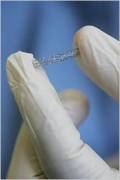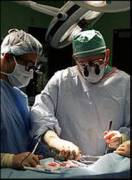
 The first monthly medical/surgery conference was a great success. Attended by resisdents and attendings from both departments the conference was a lively discussion regarding the controversies in caring for a 51 year old man who recently underwent a percutaneous coronary intervention with the placement of a Cypher stent after a non-st elevation myocardial infarction, who soon afterwards was found to have a gall bladder mass that needed to be resected. The complete slide presentation can be found here: Joint Medicine-Surgery Conference Slides
The first monthly medical/surgery conference was a great success. Attended by resisdents and attendings from both departments the conference was a lively discussion regarding the controversies in caring for a 51 year old man who recently underwent a percutaneous coronary intervention with the placement of a Cypher stent after a non-st elevation myocardial infarction, who soon afterwards was found to have a gall bladder mass that needed to be resected. The complete slide presentation can be found here: Joint Medicine-Surgery Conference Slides
A short summary of teaching points follows.
Teaching Points
Cholangiocarcinoma
- A gallbladder mass often presents with typical biliary symptoms such as biliary colic, acute cholecystitis, or obstructive jaundice. It is, therefore, often an incidental finding on ultrasound and asymmetrical thickness of one centimeter is used as a cutoff for intervention.
- 74 to 92 % of patient with cholangiocarcinoma have gallstones.
- chronic cholecystitis is a risk factor for the development of gallbladder cancer.
- Resection is the only hope for cure.
- Diagnosis is usually made by either ultrasound or CT scan with contrast and biopsies are rarely performed.
- Carcinomas that are resected in early stages, T1, have a remarkably low 5-year mortality with around 85 to 100% of patients living 5 years after resection. Still, the overall 5-year mortality is dismal at around 5 to 10 % since most cancers are found at later stages. Open cholesystectomy is preferred over laparoscopic resection as a port site seeding has been a documented phenomenon.
The surgeons felt that given the highly vascular architecture of the liver and the fact that patients with hepatic dysfunction are already at higher risk of coagulopathy, hemostasis is extremely difficult and surgery would have to be delayed once the patient was off of anitplatelet therapy. Drug coated stents
- Drug coated stents work by preventing early endothelialization and smooth muscle proliferation thereby decreasing the rate of restenosis.
- By preventing early endothelialization, the metal structure of the drug coated stents is exposed. This metal structure is pro-thrombotic and can lead to in-stent thrombosis which is a life-threatening condition.
- Clopidigrel is recommended for six weeks for bare metal stents, three months for Cypher stents, and six months for taxus stents.
- Since there are no studies investigating whether anti-platelet therapy should be continued in patients requiring surgery, recommendations are that surgery should be delayed if possible. If not, possible, patients should be assessed for bleeding risk.
- Patients undergoing a surgery with a low risk of bleeding should be continued on low dose plavix and aspirin, while patients with a higher risk can be bridged with either perioperative heparin or glycoprotein IIb/IIIa inhibitor

One comment on “The First Joint Medical-Surgery Conference”
Please let me know about any cases you think would be interesting to present for this conference. janjim01@med.nyu.edu
Comments are closed.